“My mother’s early years triggered her love for the environment”
Activist Wanjira Mathai on inspiring children, growing food, and continuing her mother’s work
Activist Wanjira Mathai on inspiring children, growing food, and continuing her mother’s work

Wanjira Mathai, 49, is the Vice President and Regional Director for Africa for the World Resources Institute of Washington DC, USA (based in Nairobi, Kenya) and Chair of the Wangari Maathai Foundation. She has also served as Chair of the Green Belt Movement, the environmental organisation founded in 1977 in Kenya by her mother, 2004 Nobel Peace Laureate Wangari Maathai.
In conversation with journalist K.A. Dilday

Wanjira Mathai
Your mother, the Nobel Peace Prizewinner Wangari Maathai, started the Green Belt Movement when you were very young. What is your earliest memory of being involved with nature and the environment?
I always remember when we planted a flowering shrub. It’s a plant that has purple, white and bluish flowers. And the reason I remember is that when that plant eventually grew, every day those flowers seemed to change colour. So, the shrub looked the same, but a flower that was white one day was purple the next. As a child I thought it was fascinating, and I remember thinking: “We planted that.”
When did you know that preserving the environment would be your life’s work?
I always say this work found me. I went to college in upstate New York. I studied biology and I did well in it, but there was never a thought to study environmental science. At that time, I thought I wanted to go into medicine. I wasn’t thinking about the environment at all.
I did a master’s degree in public health and worked for six years at the Carter Presidential Center on public health issues, focusing on disease eradication, epidemiology and understanding disease cycles, especially in the global south. I decided I wanted to learn how to communicate more effectively to change behaviour – that was really my motivation to do something different, but I didn’t know what that was. I eventually decided to go home to take a break.
Everybody thought I was crazy to be packing up my life to return home with no job, no nothing. I booked a one-way ticket back to Kenya, and after a while my mother asked me to help her deal with the international affairs of the Green Belt Movement. It had been my intention to return to the USA after a year, but I got very absorbed in the work.
Only when I was inside the movement did I think to myself, “Wow, this is an amazing thing that’s going on here.” I understood my mother’s motivation so much better and why she was so committed. This was the journey of her life, her life’s work.
So for all those years, I ended up staying and working with my mother and travelling the world. When she passed away, in 2011, I felt such a sense of deep gratitude that I’d had that time with her. Working together every day around the world in some of the most beautiful places. I really had some of the most amazing moments in my life with her. I thought “This is it and I love what I’m doing.”
What was it that made you go “wow?”
Women are often the custodians of food in communities, and nutrition we know is crucial for the early years. If children have a healthy start and eat healthy food then of course their development is influenced by that. And with the devastation and degradation of the environment comes interference with food systems. You start to see farming fail and people unable to grow the crops that they were accustomed to. A lot of crops, for example, are grown in marshy grounds, and if there’s no more marshy areas you can’t grow certain crops.
The Green Belt Movement was based around restoring land, securing food, securing water and ensuring fuel security. So, getting women to plant trees was a symbol of reclaiming your ability to manage what you have – your natural environment – and there was also a component of food and food security at a family level. The movement empowered women financially. And research has been done across the board that when women have the financial wherewithal, they invest the majority of it back into their children, their families and the community. And so when they win, a lot of people win.
The Green Belt Movement helped women understand that they didn’t have to wait for someone else to produce food for them, they could actually do it in their environment. They could plant fruit trees, and before you knew it, you had fruit. They could plant fodder trees and feed their animals. So this whole idea of a very supportive connection to nature was very much what it was all about. That was beautiful.
Are there any environmental issues that you think are not getting enough attention?
Air quality is an important one. It’s within our reach, especially in our cities. We need to make sure we continue to green our spaces so that we clean the air. It’s so clear that when you devastate the environment, the quality of the air goes down.
There’s also mobility: I’d love to see more inclusive cities. Most of the cities in my part of the world are still obsessed with vehicles. We still build cities for cars. We build pedestrian crossings for cars. We’ve got to reorient how we think, and I think part of the climate agenda is creating more inclusive cities where people can walk more, ride their bikes more, and access green spaces more easily.
What are your plans for the future to make a better world for those who come after us?
I really hope that with the work we do at the Wangari Maathai Foundation, and the work I am now doing with the World Resources Institute, we can inspire new leadership. One of the most important things for me is that we inspire youth leadership and that the next generation of leaders will have a deeper sense of purpose.
How can we push those good causes so we can really build together towards a more sustainable world?
With my mother, I know that what triggered her love for the environment was her early years – how she loved playing in the river with the tadpoles, under the leaves of the arrowroots. She would spend hours and hours there. It was clear to us that if children were more exposed to the environment at a young age, they would have the opportunity to love nature too.
You know the statement: “You will protect what you love”? That’s the way to get children in.
The World Resources Institute is a research organisation that works with governments and organisations to protect nature and improve lives. The Wangari Maathai Foundation advances the legacy of Wangari Maathai. The Green Belt Movement takes a grassroots approach to protecting the environment through tree planting, building climate resilience and empowering communities – especially women and girls – to expand democratic spaces, protect and restore nature, and create sustainable livelihoods.
See how we use your personal data by reading our privacy statement.
This information is for research purposes and will not be added to our mailing list or used to send you unsolicited mail unless you opt-in.
See how we use your personal data by reading our privacy statement.